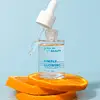What's inside
What's inside
 Key Ingredients
Key Ingredients

 Benefits
Benefits

 Concerns
Concerns

 Ingredients Side-by-side
Ingredients Side-by-side

Water
Skin ConditioningGlycerin
HumectantPropylene Glycol
Humectant3-O-Ethyl Ascorbic Acid
Skin ConditioningNiacinamide
SmoothingBetaine
HumectantSerine
MaskingTaurine
BufferingSodium Hyaluronate
HumectantGlycyrrhiza Uralensis Root Extract
Skin ConditioningGentiana Scabra Root Extract
Skin ConditioningChamomilla Recutita Flower Extract
MaskingCentella Asiatica Root Extract
Skin ConditioningRosmarinus Officinalis Extract
AntimicrobialCarbomer
Emulsion StabilisingHydroxyethylcellulose
Emulsion StabilisingTriethanolamine
BufferingDisodium EDTA
PEG-40 Hydrogenated Castor Oil
EmulsifyingPhenoxyethanol
PreservativeEthylhexylglycerin
Skin ConditioningParfum
MaskingWater, Glycerin, Propylene Glycol, 3-O-Ethyl Ascorbic Acid, Niacinamide, Betaine, Serine, Taurine, Sodium Hyaluronate, Glycyrrhiza Uralensis Root Extract, Gentiana Scabra Root Extract, Chamomilla Recutita Flower Extract, Centella Asiatica Root Extract, Rosmarinus Officinalis Extract, Carbomer, Hydroxyethylcellulose, Triethanolamine, Disodium EDTA, PEG-40 Hydrogenated Castor Oil, Phenoxyethanol, Ethylhexylglycerin, Parfum
Water
Skin ConditioningGlycerin
HumectantPhenoxyethanol
PreservativePropylene Glycol
HumectantBis-PEG-18 Methyl Ether Dimethyl Silane
EmollientSodium Hyaluronate
HumectantCI 77015
Cosmetic ColorantEthylhexylglycerin
Skin ConditioningXanthan Gum
EmulsifyingCarbomer
Emulsion StabilisingTitanium Dioxide
Cosmetic ColorantGlyceryl Caprylate
EmollientMalva Sylvestris Leaf Extract
Skin ConditioningCitric Acid
BufferingSodium Hydroxide
BufferingDendrobium Nobile Extract
Skin ConditioningPaeonia Lactiflora Root Extract
Skin ConditioningCaprylyl Glycol
EmollientAcetyl Hexapeptide-8
HumectantPentapeptide-18
Skin ConditioningSodium Glutamate
MaskingWater, Glycerin, Phenoxyethanol, Propylene Glycol, Bis-PEG-18 Methyl Ether Dimethyl Silane, Sodium Hyaluronate, CI 77015, Ethylhexylglycerin, Xanthan Gum, Carbomer, Titanium Dioxide, Glyceryl Caprylate, Malva Sylvestris Leaf Extract, Citric Acid, Sodium Hydroxide, Dendrobium Nobile Extract, Paeonia Lactiflora Root Extract, Caprylyl Glycol, Acetyl Hexapeptide-8, Pentapeptide-18, Sodium Glutamate
Ingredients Explained
These ingredients are found in both products.
Ingredients higher up in an ingredient list are typically present in a larger amount.
Carbomer is a polymer of acrylic acid. Its main role is to create a gel consistency.
A high amount of carbomer can cause pilling or balling up of products. Don't worry, most products contain 1% or less of carbomer.
Ethylhexylglycerin (we can't pronounce this either) is commonly used as a preservative and skin softener. It is derived from glyceryl.
You might see Ethylhexylglycerin often paired with other preservatives such as phenoxyethanol. Ethylhexylglycerin has been found to increase the effectiveness of these other preservatives.
Glycerin is already naturally found in your skin. It helps moisturize and protect your skin.
A study from 2016 found glycerin to be more effective as a humectant than AHAs and hyaluronic acid.
As a humectant, it helps the skin stay hydrated by pulling moisture to your skin. The low molecular weight of glycerin allows it to pull moisture into the deeper layers of your skin.
Hydrated skin improves your skin barrier; Your skin barrier helps protect against irritants and bacteria.
Glycerin has also been found to have antimicrobial and antiviral properties. Due to these properties, glycerin is often used in wound and burn treatments.
In cosmetics, glycerin is usually derived from plants such as soybean or palm. However, it can also be sourced from animals, such as tallow or animal fat.
This ingredient is organic, colorless, odorless, and non-toxic.
Glycerin is the name for this ingredient in American English. British English uses Glycerol/Glycerine.
Learn more about GlycerinPhenoxyethanol is a preservative that has germicide, antimicrobial, and aromatic properties. Studies show that phenoxyethanol can prevent microbial growth. By itself, it has a scent that is similar to that of a rose.
It's often used in formulations along with Caprylyl Glycol to preserve the shelf life of products.
Propylene Glycol is an odorless, colorless liquid. As a humectant, it helps skin retain moisture. It also aids in delivering active ingredients.
Another role of this ingredient is preventing a product from melting or freezing. Propylene glycol also adds antimicrobrial properties to a product, elongating product lifespan.
This ingredient is considered an organic alcohol and commonly added into both cosmetics and foods.
Those with sensitive skin or conditions may develop a rash when using this ingredient.
Learn more about Propylene GlycolSodium Hyaluronate is hyaluronic acid's salt form. It is commonly derived from the sodium salt of hyaluronic acid.
Like hyaluronic acid, it is great at holding water and acts as a humectant. This makes it a great skin hydrating ingredient.
Sodium Hyaluronate is naturally occurring in our bodies and is mostly found in eye fluid and joints.
These are some other common types of Hyaluronic Acid:
Learn more about Sodium HyaluronateWater. It's the most common cosmetic ingredient of all. You'll usually see it at the top of ingredient lists, meaning that it makes up the largest part of the product.
So why is it so popular? Water most often acts as a solvent - this means that it helps dissolve other ingredients into the formulation.
You'll also recognize water as that liquid we all need to stay alive. If you see this, drink a glass of water. Stay hydrated!
Learn more about Water